Project self-propelled artillery installation Heuschrecke (Germany)
Since the end of the 1930s, Krupp has been working on projects of various armored vehicles, including self-propelled artillery mounts. One of the results of these works was the formation of the shape of the ACS with a full-turn turret, in which it was proposed to install an existing artillery gun. A similar concept was tested in the Sd.Kfz project. 165 / 1, which has come down to the construction of the pre-production lot and its military tests. The new SAU did not go into the series, but became the basis for the next project, in which it was proposed to use a non-standard original technical solution.
Unfortunately, there are no exact information about the prerequisites for the appearance of the original proposal. For some reasons, probably related to questions of mobility and tactics of use, it was decided to build not just a self-propelled gun, but an ACS with the function of an arms transporter. It was proposed to equip a promising machine with a rotating turret, as well as a special crane, with the help of which the turret could be quickly removed from the shoulder strap and installed on an appropriate base. In addition, it was proposed to provide towing of the removed tower with the help of the ACS hull or another tractor.
Such an appearance allowed the prospective self-propelled gun, depending on the tactical need, to fire at the enemy (including on the move), to bring ammunition, to work as a repair and recovery vehicle, etc. The tower removed from the hull, in turn, could turn into a stationary firing point with cannon armament. The proposed idea was extremely bold and even dubious, but still received approval from the leaders of the developer and customer.
Work on the new project started in 1942 year. The development received the symbol Heuschrecke ("Locust"). In the future, additional indexes were added to the name, denoting different versions of the project, different prototype machines, etc. In addition, the complex official designation 10.5 cm leFH 18 / 1 (Sf) auf Geschützwagen IVb - “105-mm lightweight howitzer on the Geschützwagen IVb chassis” was used. The project proposed the most active use of existing components and assemblies, which allowed to speed up development.
The Geschützwagen IVb chassis from Hummel self-propelled guns, built on the basis of the self-propelled gun, was chosen as the basis for the new self-propelled tanks PzKpfw III and PzKpfw IV. At the same time, the chassis of the basic self-propelled gun was finalized in connection with the peculiarities of the Locust layout. The fact is that when the Hummel self-propelled gun was created, German engineers were forced to rework the base tank chassis and move its engine to the middle of the hull, freeing up the space for the fighting compartment in the stern. The new Heuschrecke self-propelled gun was supposed to have a middle fighting compartment, which is why the engine returned to the stern.
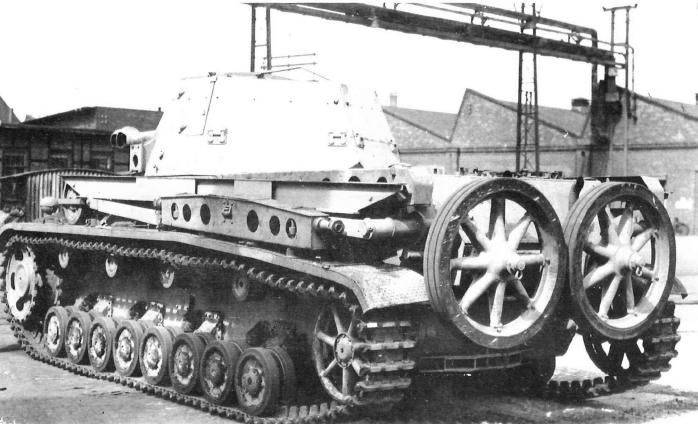
View of the stern. The wheels of the cart for the tower are mounted on mounts
The chassis body was welded from several rolled armor plates of various thickness. The frontal part of the body was formed by several sheets placed at an angle to each other. The maximum thickness of the frontal barrier was 30 mm. The side view and hull feeds were protected by 16-mm sheets. The roof and bottom were the thinnest elements of armor and were only 10 mm thick. The layout of the hull was standard for German tanks of the Second World War. In front of the station there were transmission units and a control compartment. The center housed the fighting compartment, under the floor of which the cardan shaft passed. Feed was given under the engine and part of the transmission.
The basis of the power plant was to be a Maybach gasoline engine. It was planned to equip prototypes of self-propelled guns with HL90 engines of 360 horsepower, while serial machines were supposed to be equipped with HL100 motors of HP 410 power. The mechanical transmission was unchanged borrowed from the base chassis.
The chassis of the used chassis was a development of the design of the PzKpfw IV tank with the introduction of some parts from the PzKpfw III. She had eight interconnected pairs of track rollers on each side. In the rear part of the hull there were guide wheels, in the front - relatively large leading ones. Due to certain circumstances, the drive wheels were borrowed from the tank PzKpfw III. Under the upper branch of the track there were four supporting rollers on each side.
On the roof of the case there was a shoulder strap for installing a tower with weapons. The tower itself was an armored unit with a thickness of protection from 30 mm (forehead and mask) to 16 mm (sides and stern). The front part of the tower was formed by a frontal and two zygomatic leaves tilted inward. Behind them were two sides, behind which was provided feed, consisting of two parts. The roof of the tower was not used. An interesting feature of the Heuschrecke ACS tower was the use of sides and aft, consisting of two parts. The lower part of the sides and the stern was fixed rigidly, and the upper could recline. In this case, the bevelled parts of the sides were folded forward and down, and the aft "hatches" - only down. Due to this design of the sides it was possible to slightly increase the volumes available to the crew.
The main weapons The prospective self-propelled gun "Locust" was supposed to be a light field howitzer leFH18 / 1 caliber 105 mm with a barrel length 28 caliber and a muzzle brake. The gun was mounted in the frontal installation of the tower, which allowed to direct it within the vertical sector from 0 ° to + 68 °. The circular horizontal guidance was provided by turning the entire tower. The gun was completed with a slfZF2 telescopic sight. The characteristics of the gun made it possible to fire targets at ranges up to 10,6 km. Due to the possibility of firing with large elevation angles, the howitzer could fire direct fire or from closed positions, solving various combat missions. Ammunition consisted of 60 shells. All of these munitions were located in the styling of the crew compartment.
The crew of the new SAU was to consist of five people: the driver, radio operator, commander, gunner and loader. The driver and radio operator were in front of the hull, the rest of the crew had to work in the tower. When removing the tower or returning it to its place, the crew also had to perform the functions of crane operators, scaffold gear, etc. For landing, the crew had to use the hatches in the hull and the open top of the tower.
On the roof of the hull, on the sides of the tower and on the stern sheet, in the stowed position housed the most interesting equipment self-propelled guns - various means for working with the tower. The main element of this “complex” was a collapsible crane, actually consisting of two independent bridge-type cranes. In the central and aft part of the sides there were articulated fastenings for four swinging supports (two for each side). From above, two beams with rails for moving hoists were connected with supports. In order to avoid breakdown of the hoists, folding safety devices were provided at the ends of the rails. In the stowed position, the elements of the crane were folded forward and placed along the sides, without interfering with the work of the crew and turning the tower. To use the crane, it was necessary to raise the beams and install supports with a backward tilt.
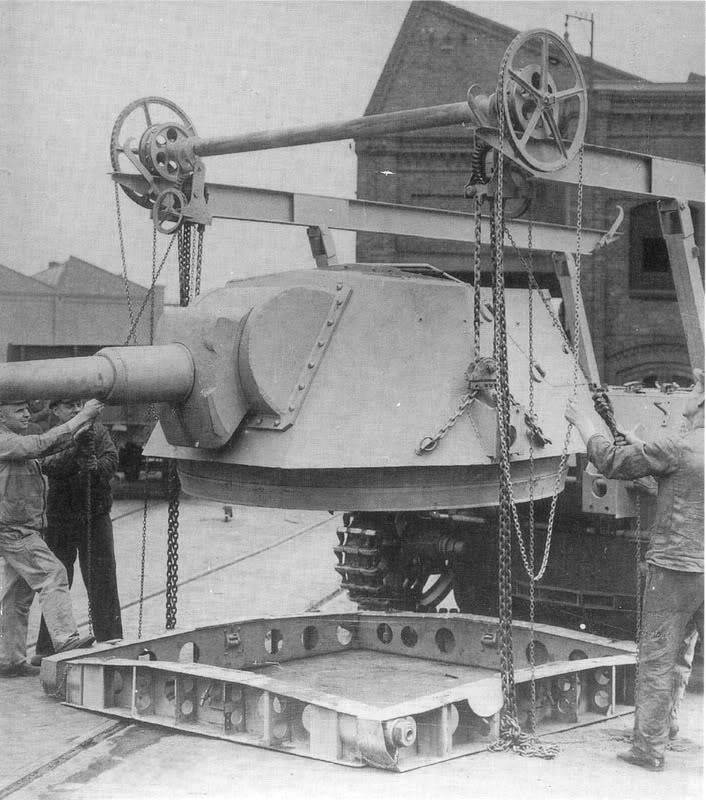
The descent of the tower on the trolley frame
In preparation for the operation of the crane on the beams were installed two hoists with manual transmission. With their help, it was proposed to raise the tower from its place, move the beams along the rails and lower it to the ground or another support. To interact with the chains of hoists on the sides of the tower a set of hooks was provided. Due to the correct position, taking into account the balancing of the tower, the hooks made it possible to remove the tower without any problems or install it back.
The project Heuschrecke provided funds not only for lowering the tower on a support or for lifting back. If necessary, self-propelled guns or other machines could tow the removed tower to the right place. For this purpose, a special metal frame was developed with attachments for the wheels. In the stowed position, the frame was disassembled transported on the roof of the chassis engine compartment and on the sides, and the wheels were mounted on the stern sheet. If necessary, three parts were removed from their seats and assembled in a cart suitable for towing.
The proposed complex of special equipment allowed to solve a number of specific tasks. If necessary, the SAURA self-propelled gun could unload the turret on the prepared support and turn it into a stationary firing point. The released chassis could then be used as a carrier for ammunition, as well as perform other functions. In particular, the presence of a crane allowed the machine to participate in the repair of equipment.
According to calculations, the total length of the advanced self-propelled gun did not exceed 6 m, and the width and height (with the turret) were within 3 m. Despite the presence of a relatively heavy gun and large ammunition, the combat mass remained at the level of 23 t. machine show good characteristics of mobility, allowing its use in the troops.
At the very beginning of 1943, Krupp built three prototypes of a new type of ACS. This technique received the designation Heuschrecke 10 or Heuschrecke IV. Until the end of winter, three prototypes managed to pass the necessary tests and show their potential. Driving performance remained at the level of tanks PzKpfw IV. Thus, the maximum speed on the highway reached 45 km / h, power reserve - up to 300 km. From the point of view of overcoming obstacles, self-propelled weapons did not differ much from the tanks available in the troops.
According to the test results, the development of an upgraded version of the Heuschrecke ACS with a new engine and another tool began. Due to the use of the engine Maybach HL100 410 HP and the 105-mm howitzer leFH43 proposed to increase mobility and firepower. In this case, it was planned to preserve the possibility of quickly dismantling the tower with installation on various supports. There is also information on the preliminary elaboration of similar projects based on newer tanks, such as the PzKpfw V Panther, etc. Due to the workload of the industry, all these developments have not reached practical implementation.
In the spring of 1943, a test report of three experimental self-propelled guns with removable turrets was presented to the leadership of the armored forces. Chief Inspector Pantservafe G. Guderian called the proposed SAU quite interesting. At the same time, the commander noted that the start of production of self-propelled guns can hit the construction of tanks. As a result, he came to the conclusion that the advantages of the new technology will not justify the reduction in the production of tanks associated with it. As a result, the Heuschrecke 10 ACS was not recommended for use.
According to others, the debate about the prospects of "Locust" lasted until the year 1944. Back in 42, Rheinmetall-Borsig began developing its own self-propelled gun project with an 105-mm howitzer similar to that used in the Krupp project. The prototype of this machine was built only in the spring of the year 1944. According to the test results, the military began to lean towards the development of Rheinmetall, however, they demanded to rework the chassis of the sample. At the end of 44, the command and industry tried to select the best model available and made plans for its serial construction. Such plans were not realized due to the problems of the final stage of the war.
Anyway, the three Heuschrecke 10 / IV prototype self-propelled guns, built at the start of the 1943, turned out to be the only machines of their type. Experienced self-propelled guns with more powerful engines and implements were not built or tested. After completing the tests, the three vehicles were returned to the factory, where they stayed until the end of the war. One of the experienced self-propelled guns of the Krupp company in the spring of 1945, became a trophy of the American troops. Like many other serial and prototypes found in German enterprises, this technique has undergone a thorough study. Self-propelled gun was taken to the United States, where they tested at the Aberdeen Proving Ground. Currently, the only copy of "Locust" is an exhibit of the artillery museum Fort-Sill (pcs. Oklahoma). The fate of the other two cars is unknown. They were probably destroyed during the fighting.
At the heart of the Heuschrecke project was an original and unusual idea: if necessary, the combat vehicle had to independently remove the gun tower and install it on a suitable support. The reasons for the emergence of such a proposal are not fully understood. In addition, there may be questions related to the promotion of such an original and unusual idea, as a result of which the project reached the construction stage of several prototypes with their subsequent tests. Checks confirmed the viability of the idea, but the need to reduce the production of tanks for the sake of producing new SAU put an end to a promising project.
On the materials of the sites:
http://achtungpanzer.com/
http://aviarmor.net/
http://serkoff.narod.ru/
http://williammaloney.com/
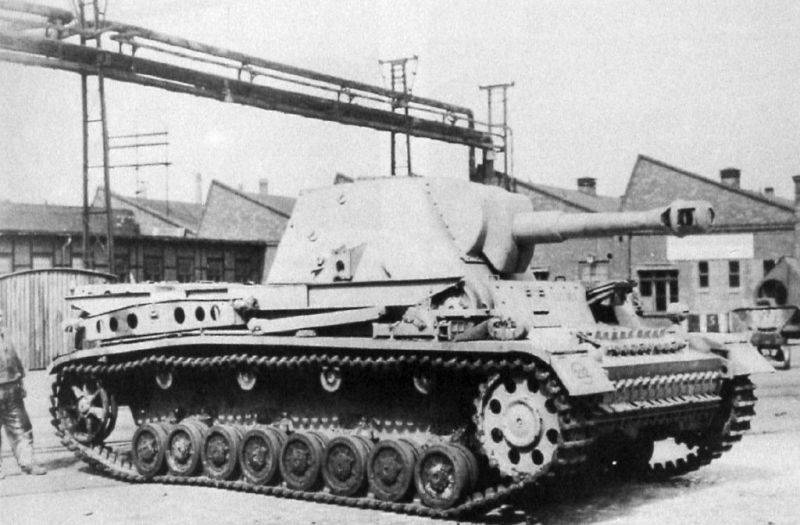
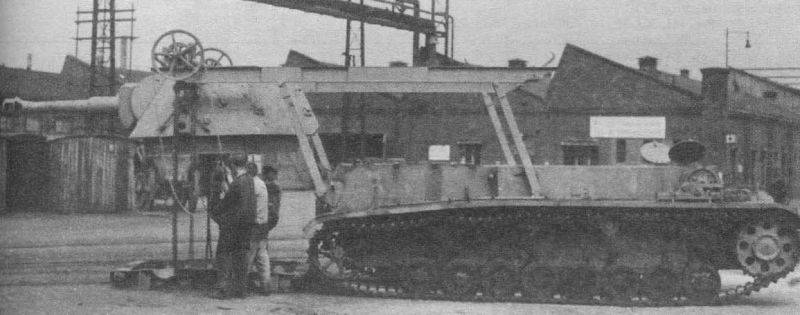
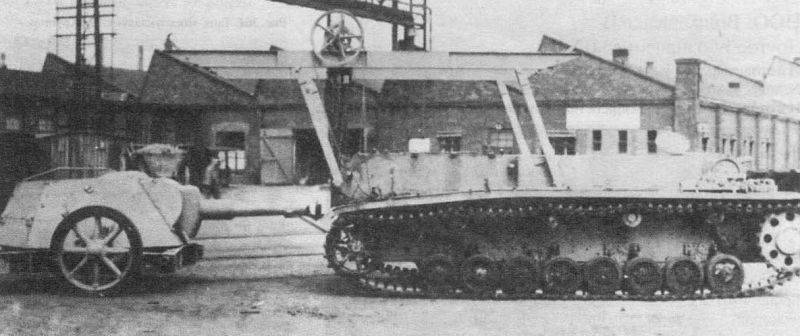
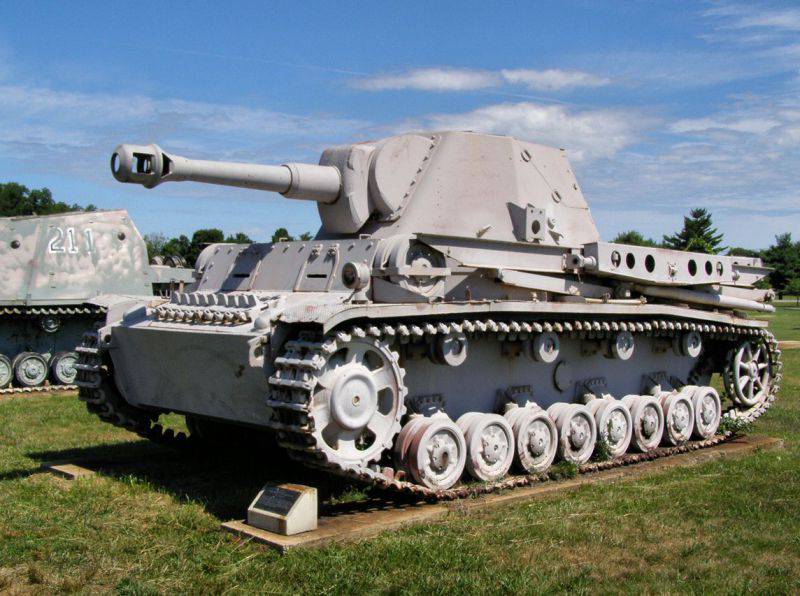
Information